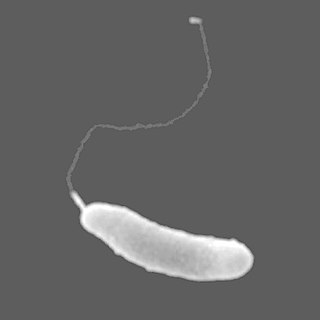Related Research Articles
Dictyoglomus is a genus of bacterium, given its own subphylum, called the Dictyoglomi. This organism is extremely thermophilic, meaning it thrives at extremely high temperatures. It is chemoorganotrophic, meaning it derives energy by metabolizing organic molecules. This organism is of interest because it elaborates an enzyme, xylanase, which digests xylan, a heteropolymer of the pentose sugar xylose. By pretreating wood pulp with this enzyme, paper manufacturers can achieve comparable levels of whiteness with much less chlorine bleach.

Shigella boydii is a Gram-negative bacterium of the genus Shigella. Like other members of the genus, S. boydii is a nonmotile, nonsporeforming, rod-shaped bacterium which can cause dysentery in humans through fecal-oral contamination.

Anaplasma phagocytophilum is a Gram-negative bacterium that is unusual in its tropism to neutrophils. It causes anaplasmosis in sheep and cattle, also known as tick-borne fever and pasture fever, and also causes the zoonotic disease human granulocytic anaplasmosis.
The Gemmatimonadetes are a phylum of bacteria created for the type species Gemmatimonas aurantiaca. This bacterium makes up about 2% of soil bacterial communities and has been identified as one of the top nine phyla found in soils; yet, there are currently only six cultured isolates. Gemmatimonadetes have been found in a variety of arid soils, such as grassland, prairie, and pasture soil, as well as eutrophic lake sediments and alpine soils. This wide range of environments where Gemmatimonadetes have been found suggests an adaptation to low soil moisture. A study conducted showed that the distribution of the Gemmatimonadetes in soil tends to be more dependent on the moisture availability than aggregation, reinforcing the belief that the members of this phylum prefer dryer soils. The phylum Gemmatimonadetes is distinct from the phylum Cyanobacteria and may have diverged in early microbial evolution at least 3 billion years ago.
Halopiger is a genus of archaeans in the family Halobacteriaceae that have high tolerance to salinity.
Ehrlichia ewingii is a species of rickettsiales bacteria. It has recently been associated with human infection, and can be detected via PCR serological testing. The name Ehrlichia ewingii was proposed in 1992.

Deinococcus is one genus of three in the order Deinococcales of the bacterial phylum Deinococcus-Thermus highly resistant to environmental hazards. These bacteria have thick cell walls that give them Gram-positive stains, but they include a second membrane and so are closer in structure to Gram-negative bacteria. Deinococcus survive when their DNA is exposed to high doses of gamma and UV radiation. Whereas other bacteria change their structure in the presence of radiation, such as by forming endospores, Deinococcus tolerate it without changing their cellular form and do not retreat into a hardened structure. They are also characterized by the presence of the carotenoid pigment deinoxanthin that give them their pink color. They are usually isolated according to these two criteria.
Halococcus salifodinae is an extremely halophilic archaeon, first isolated in an Austrian salt mine. It is a coccoid cell with pink pigmentation, its type strain being Blp.
Magnetococcus marinus is a species of Alphaproteobacteria that has the peculiar ability to form a structure called a magnetosome, a membrane-encased, single-magnetic-domain mineral crystal formed by biomineralisation, which allows the cells to orient along the Earth’s geomagnetic field.
Arthrobacter cryoconiti is a psychrophilic, Gram-positive, aerobic and non-motile bacterium species from the genus of Arthrobacter which has been isolated from cryoconite from the Banker glacier in the Ötztaler Alpen in Austria.
Marinobacter antarcticus is a Gram-negative, aerobic, halotolerant, rod-shaped and motile bacterium from the genus of Marinobacter which has been isolated from Antarctic sediments.
Hymenobacter koreensis is an extremely halophilic and aerobic bacterium from the genus of Hymenobacter which has been isolated from a salt mine in Wensu County in China.
Laceyella sediminis is a thermophilic bacterium from the genus of Laceyella which has been isolated from sediments from a hot spring in Tengchong in China.
Novosphingobium oryzae is a plant-promoting bacterium from the genus of Novosphingobium.
Infectious coryza is a serious bacterial disease of chickens which affects respiratory system and it is manifested by inflammation of the area below the eye, nasal discharge and sneezing. The disease is found all over the world causing high economic losses. Economic loss is due to stumping off and reduction of egg production in case of laying chickens. The disease was discovered early 1930s by considering clinical signs.

Marinomonas arctica is a Gram-negative, psychrotolerant and motile bacterium from the genus of Marinomonas which has been isolated from sea-ice from the Canadian Basin from the Arctic Ocean.
Aquibacillus is a genus of bacteria from the family of Bacillaceae.
Aquibacillus albus is a Gram-positive, strictly anaerobic and moderately halophilic bacterium from the genus of Aquibacillus which has been isolated from the Lop Nur lake from Xinjiang in China.
Aquibacillus halophilus is a Gram-positive and moderately halophilic bacterium from the genus of Aquibacillus.
Aliidiomarina maris is a bacterium from the genus of Aliidiomarina which has been isolated from sediments from the South China Sea.
References
- 1 2 "Aquibacillus". LPSN .
- 1 2 3 "Aquibacillus salifodinae". www.uniprot.org.
- ↑ Zhang, Wei-Yan; Hu, Jing; Zhang, Xin-Qi; Zhu, Xu-Fen; Wu, Min (3 December 2014). "Aquibacillus salifodinae sp. nov., a novel bacterium isolated from a salt mine in Xinjiang province, China". Antonie van Leeuwenhoek. 107 (2): 367–374. doi:10.1007/s10482-014-0335-9. PMID 25465850.
| This Firmicutes-related article is a stub. You can help Wikipedia by expanding it. |